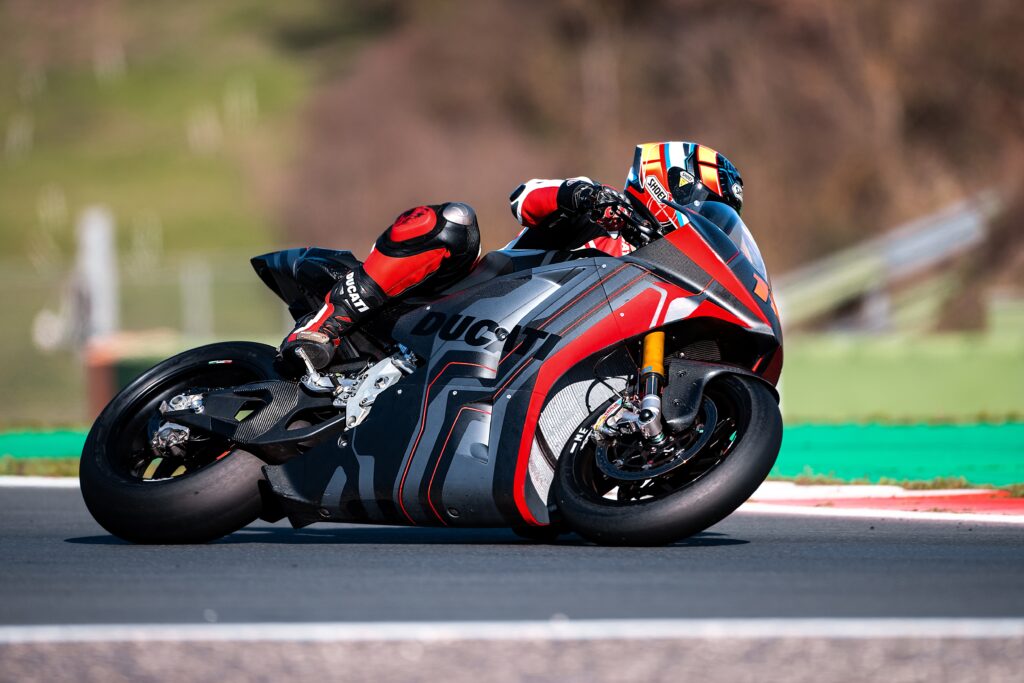Ducati has released technical details of its MotoE project, with Claudio Domenicali, the company’s CEO, commenting, “A few weeks ago I had the extraordinary opportunity to ride the Ducati MotoE on the track and I immediately realized that I was living in a historic moment. The world is going through a complex period and environmental sustainability is an element that all individuals and all companies must consider a priority if we want to preserve the delicate balance of the planet.
“At Ducati, we have grasped this need and we went in search of a challenge that would allow us to contribute to the common goal of reducing CO2 emissions and at the same time to keep faith with our DNA linked to racing. We agreed with determination to develop the best-performing electric racing bike that current technology makes possible and to use this project as a laboratory in which to build our future. The result we have achieved is surprising. As soon as I sat on the bike, I realized the quality of the work done by the team, and when I returned to the garage I felt a deep sense of pride for what we were once again able to achieve.”
The Bologna-based motorcycle manufacturer harnessed the skills of its production and racing departments, reportedly using a development methodology more common in production bikes. Ducati R&D took care of project management activities, together with the design and simulation of the electric powertrain; the design of the MotoE was handled by the Centro Stile Ducati, which also created the livery of the bike. Ducati Corse worked on the electronic parts design, software controls and strategies, simulations of the dynamics and aerodynamics of the motorcycle and finally on the bike assembly, testing and data acquisition processes.
Vincenzo De Silvio, Ducati’s R&D director, remarked, “For Ducati, having the opportunity to become suppliers of the FIM MotoE World Cup is not only a technologically exciting venture but also the best way to interpret the challenges of the new millennium. Racing competition represents the ideal terrain on which to develop innovative technologies that will then transfer to production motorcycles. At this moment, the most important challenges in this field remain those related to the size, weight, autonomy of the batteries and the availability of the charging networks. Ducati’s experience in the FIM MotoE World Cup will be a fundamental support for product R&D, together with the physiological evolution of technology and chemistry. Helping the company’s internal expertise to grow is already essential today to be ready when the time comes to put the first street electric Ducati into production.”
The resulting bike has a total weight of 225kg (12kg less than the target weight suggested by Dorna and FIM for a bike capable of completing the race distance) with maximum power and torque figures of 110kW (150bhp) and 140Nm respectively, which allowed for a top speed of 275km/h on the track in Mugello, Italy.
The battery pack weighs 110kg and has a capacity of 18kWh with a 20kW charging socket integrated into the tail. The pack houses 1,152 cylindrical 21700 cells. The 800V electrical system uses a 5kg inverter derived from a Formula E unit; the motor (21kg weight and a maximum speed of 18,000rpm) was developed by an as-yet-unnamed technical partner. The liquid cooling system is a dual-circuit design to cover the different thermal needs of the battery pack and the motor/inverter unit. The carbon-fiber outer case for the battery pack also acts as a stressed part of the chassis.
Roberto Canè, Ducati’s director of e-mobility, concluded, “I remember the birth of the MotoE project and every phase of the composition of the work team well, with the involvement of Ducati Corse colleagues and the search for contacts within the Volkswagen Group who could give us suggestions on how to develop this project. To make this bike we followed the same procedure that we usually follow on a production bike. We started by defining the design of the bike and in parallel, the technical office began to design the various vehicle components. The initial brief was to create a racing bike that respected the minimum performance characteristics required by Dorna. As a matter of fact, this project has made and is making the whole team involved fall in love and is pushing us to create a bike with better characteristics than initially requested by the organizer.”



